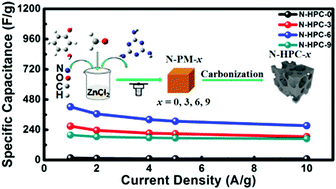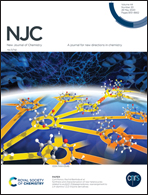N-Doped 3D hierarchical carbon from resorcinol–formaldehyde–melamine resin for high-performance supercapacitors†
Abstract
N-Doped hierarchical porous carbons (HPCs) with tailored pore structures were fabricated via simultaneously foaming and carbonizing resorcinol–formaldehyde–melamine resin under a hypersaline condition using ZnCl2 salt. The obtained carbon aerogels possessed a high surface specific area (700–850 m2 g−1) with uniquely hierarchical porous nanoarchitectures, primarily containing ultramicropores, supermicropores and mesopores, and high residuals of nitrogen heteroatoms (5.36–7.25 wt%), because ZnCl2 acts as the dehydration agent, foaming agent, and porogen collectively. Herein, HPCs, obtained from using ZnCl2 in a proper quantity, exhibited an exceptionally specific capacitance of 423 F g−1 at 1 A g−1, a superior cycling stability after 10 000 cycles at 2 A g−1 and a distinctively high coulombic efficiency (near 100% after 10 000 cycles) as well. In particular, contributions of both double-layer capacitances and pseudocapacitances were determined, where pseudocapacitance accounts for 79% of the total capacitance. The assembled flexible solid state supercapacitor yielded a high energy density of 16.7 W h kg−1 at a power density of 894.0 W kg−1, exhibiting a high cycling stability and flexibility. Our results suggest that a facile and environmentally friendly hypersaline strategy can be utilized to prepare new N-doped HPCs, and moreover their electrochemical performance can be tuned conveniently. Since such HPCs have an exceptional electrochemical property, they have promising potential as carbon substrates in supercapacitive materials or wearable devices.



 Please wait while we load your content...
Please wait while we load your content...